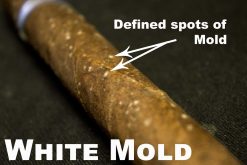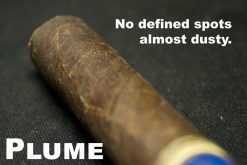You open your humidor. You see some splotchy white spots on your cigar. You fear that something is wrong with your cigar. You do an internet search and find a saving grace! It is a thing called “Plume”! HOORAY! Your cigars aren’t ruined, and in fact they have become an elite, plume covered delicacy!
 Well here is where I become the bearer of bad news. To steal a saying from my friends over at /r/cigars, “That’s Mold Bro!”. Plume has become one of the most misunderstood (and overly used terms) in the cigar industry. Unfortunately, it’s due to many people trying to cover up the fact that their cigars have become moldy. Plume is rare and very subtle. A cigar with plume is a cigar that has been kept in proper conditions for a long time. Honestly, they don’t look very nice. They have a very old look to them. Essentially, instead of an oily sheen to the cigar, it gains a flat look with what appears to be a non-tangible dusting to them. So, if you put that cigar in your humidor 6 months ago, or you are at a cigar shop and looking at their regular stock and you see a cigar with a fuzzy substance on it, that is mold, NOT Plume.
Well here is where I become the bearer of bad news. To steal a saying from my friends over at /r/cigars, “That’s Mold Bro!”. Plume has become one of the most misunderstood (and overly used terms) in the cigar industry. Unfortunately, it’s due to many people trying to cover up the fact that their cigars have become moldy. Plume is rare and very subtle. A cigar with plume is a cigar that has been kept in proper conditions for a long time. Honestly, they don’t look very nice. They have a very old look to them. Essentially, instead of an oily sheen to the cigar, it gains a flat look with what appears to be a non-tangible dusting to them. So, if you put that cigar in your humidor 6 months ago, or you are at a cigar shop and looking at their regular stock and you see a cigar with a fuzzy substance on it, that is mold, NOT Plume.
Mold is preventable. Maintaining proper conditions within your humidor is a good start. Mold is caused by too much humidity, therefore the easiest way to prevent mold is constantly making sure your humidity levels do not exceed 70%rh humidity. Personally, I prefer the 63%rh to 66%rh range for my cigars, and do everything I can to maintain the levels in that range. Mold can begin to form on a cigar, once the total saturation of the cigar gets at 74%rh or higher. It can happen quickly as well. We are dealing with nothing more than leaves and moisture, so just as it happens in nature, it can happen in your humidor.
 Cigars that are wrapped in cedar and packaged in metal tubos are often time more susceptible to surface mold because more of the humidity is trapped within the container. Think of it as a terrarium situation. The moisture is trapped within an area and can be highly effected by humidity and temperature changes. Also, cigars without cellophane are susceptible because they are in direct contact with the moisture and can develop mold quicker. A cigar can develop surface mold, or a cigar can become completely infested. Surface mold is easily wiped off, and by all accounts, do not have any harmful effects to you or the cigar. Surface mold will appear on the outside of the cigar in random white splotchy patches. Making sure the surface mold is completely gone is key though. Once, wiping off the surface mold, remove the affected cigars from the rest of your unharmed stash, and keep them in proper conditions outside of your regular humidor until you know they are mold free.
Cigars that are wrapped in cedar and packaged in metal tubos are often time more susceptible to surface mold because more of the humidity is trapped within the container. Think of it as a terrarium situation. The moisture is trapped within an area and can be highly effected by humidity and temperature changes. Also, cigars without cellophane are susceptible because they are in direct contact with the moisture and can develop mold quicker. A cigar can develop surface mold, or a cigar can become completely infested. Surface mold is easily wiped off, and by all accounts, do not have any harmful effects to you or the cigar. Surface mold will appear on the outside of the cigar in random white splotchy patches. Making sure the surface mold is completely gone is key though. Once, wiping off the surface mold, remove the affected cigars from the rest of your unharmed stash, and keep them in proper conditions outside of your regular humidor until you know they are mold free.
While inspecting your moldy cigar, always check the foot of the cigar (also known as the end that you light). If mold develops in this area, you have a big issue. Mold on the foot indicates that there is mold on the inside of the cigars. Unfortunately, these cigars should be disposed of immediately as they are not safe to smoke, and can infect the rest of your cigar collection. Any cigars with signs of greenish-colored mold should be discarded immediately as well.
The bottom line, take care of your cigars and if something goes wrong, take care of it. If you have to ask the question “Is It Mold Or Plume?”, chances are it’s mold. Don’t believe the lies and harm yourself and your cigars in doing so. Mold can happen. Take care of it and do everything you can to make sure it doesn’t happen again.

